This article is unlocked
One of the biggest changes to adjust to is how everyone will be getting around the city. People have begun to get use to not having a bus barreling by them every few minutes. Others have begun to walk more and have improved their health.
Some of the changes in transportation will be good for everyone—like finally getting the Tramvia to run—and some will help the planet—like the increased use of bicycles versus cars.
Keeping up with what has been going on with mobility in the city has been a difficult task. It seemed like new announcements were being made about transportation on a daily basis. So, it wouldn’t be a surprise if most people had no idea what was running, who was allowed to drive, and when some form of transportation will come back online.
Below, we’ve summarized all the changes that have occurred over the last three months and tried to give our readers an idea of how they can now get around the city.
One thing we are leaving out is the use of personal vehicles like cars and motorcycles. We hope that Cuenca will see less of that as the new options become more user friendly (like dedicated bike lanes, finally!). Either way, most people with personal vehicles already know what days they can drive based on the last number of their license plate. And since that changes regularly, we are leaving it up to drivers to keep track of that.
We’re going to start with the buses, since that is one of the least expensive ways to travel both in the city and out among the suburbs, or across the country to other provinces. Also, according to studies by the Llactalab Sustainable Cities Research Group of the University of Cuenca, 60% of the population in Cuenca travels by public transport, while 30% travels by private vehicle.
BUSES
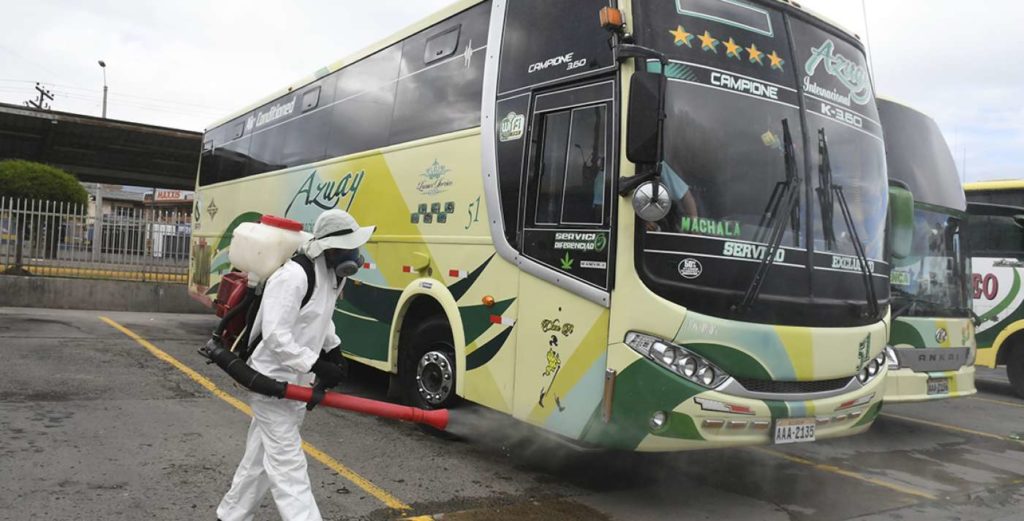 The bus system—which was shut down on March 17, 2020, when the health emergency began—has been one of the biggest issues for the municipality to deal with when it began reactivating the businesses and transportation routes in the city. The scope of the task has meant months of planning and negotiations. And at the time we went to press, there are still several issues that the city and the bus unions cannot agree upon. If that is not resolved, the city says it will dictate the terms as “the buses operate under the city’s permission,” said one of the city’s negotiators.
The bus system—which was shut down on March 17, 2020, when the health emergency began—has been one of the biggest issues for the municipality to deal with when it began reactivating the businesses and transportation routes in the city. The scope of the task has meant months of planning and negotiations. And at the time we went to press, there are still several issues that the city and the bus unions cannot agree upon. If that is not resolved, the city says it will dictate the terms as “the buses operate under the city’s permission,” said one of the city’s negotiators.
The bus owners have complained that they are still owed subsidies from the fare changes that went into effect prior to the pandemic. The city does not disagree that the bus owners are owed money. However, the city is asking that owners take into account the financial impact the health emergency has put on the canton and put that issue aside for now, so that everyone can get back to work.
Chamber of Transport of Cuenca union readies for opening
Bus owners began preparing for the transportation service to be reactivated back in mid-May. The Chamber of Transport of Cuenca announced on May 14, 2020, that it had already developed its operational plan for reactivating the city’s bus system.
At the time, they were waiting for the Cuenca Emergency Operation Committee (COE) to make the decision to move from a RED epidemiologic “traffic signal” to YELLOW one.
They also reported that once the system started again, the biosecurity measures being instituted consisted of daily cleaning and disinfection of the buses, and the requirement that drivers and riders would need to wear face masks and be disinfected once they boarded the bus.
While the bus union claimed that the bus and drivers were ready to resume service in mid-May, at that time the union began to demand that the municipality provide a plan to restore “economic balance” to the Cuenca Chamber of Transport. The union reported that its members had a debt of close to $60 million to private banks, money that was used to by the new fleet of buses that were required under a cantonal ordinance in 2019.
City receives new bus signage
Prior to reactivating the urban bus service, during the last week of May, the municipality began creating new signage and placing “circles of life” (social distancing pathways) on sidewalks at the busiest bus stops throughout the city, in order to maintain the recommended physical distance of two meters. These were installed as part of the protocols for the prevention of the spread of the COVID-19, according to regulations issued by the National COE.
In addition to the circles of life, horizontal signaling was installed to demarcate areas for each particular bus line, segmenting the physical space that each one will occupy. This was done to avoid crowds and to provide appropriate space for boarding and disembarking passengers.
Urban bus service reactivates
On Monday, June 1, 2020, bus service began to circulate in the city of Cuenca, under the new guidelines for biosafety measures and ridership reductions.
Under an agreement with the municipality that was reached on May 29, 2020, bus owners agreed to restart their services with a reduced capacity of 50% of each unit’s normal passenger load; approximately 40 to 50 passengers.
This meant 475 urban buses resumed service in Cuenca along the same routes that existed prior to the start of the pandemic.
Before they started their day, all buses were taken to the Cuenca Chamber of Transport’s service yard to be fumigated and disinfected. The fumigation was done with quaternary ammonium; disinfection was done with pure alcohol.
Under the biosafety rules, each bus had certain seats blocked out of use to ensure proper social distancing and to prevent a passenger load above the agreed upon 50%.
In addition to preparing the buses for travel, each driver was also tested for the coronavirus (during the last week of May). Not surprisingly, eleven drivers tested positive for the virus and were ordered to quarantine at home for at least 14 days prior to returning to be retested.
Cuenca Land Terminal plans for interprovincial service
At the same time that the urban bus union was preparing for opening the service throughout the city, the municipality also had to prepare the Cuenca Terrestrial Terminal for interprovincial transport once the National COE approved this extension of service and the Cantonal COE approved its biosafety protocols.
On May 29, 2020, city officials visited the terminal to review the compliance with the biosecurity measures that needed to be implemented to restart interprovincial travel. Representatives of Cuenca’s Mobility Company (EMOV EP)—who is in charge of the terminal—toured the officials through the facility.
EMOV EP’s Operational Manager of Cuenca Land Transport explained to city officials that five ozone booths had been installed for passenger disinfection and that “circles of life” had been designed for internal operations (e.g., ticket purchases and parcel deliveries), the entrance area to the buses, and entrance and exit doorways.
Throughout the entire terminal new signs were installed to remind people of social distancing requirements, recommended standards to prevent the spread of the virus and other important information.
Last week, the National COE validated the biosafety protocols that EMOV EP had implemented at Cuenca’s Terrestrial Terminal. Cuenca was the first terrestrial terminal in the country that received National COE approval, as it complies with all the established processes and the necessary protocols.
On June 13, 2020, the National COE also approved interprovincial travel to restart on June 15, 2020. The reopening implies that all the buses that leave one city can go to the cantons that are yellow and green as long as the corresponding Cantonal COE approves the opening of the terrestrial terminals.[Quito, the most populated canton in the country, will reopen interprovincial travel on July 1, 2020.]
Cuenca’s Terrestrial Terminal is now awaiting approval from the Cantonal COE to begin interprovincial travel. The Cantonal COE was meeting on Monday, June 15, 2020, to make a decision on approving its protocols.In addition, the Cantonal COE will analyze the state of the terminals of the nearby cantons, to ensure that they all comply with biosafety protocols.
EMOV EP reported that the routes and the operators that will provide service will also be discussed at the Cantonal COE meeting. The date for the restart of interprovincial travel from Cuenca is not yet known.
Either way, the reactivation will be progressive. The Cantonal COE of each jurisdiction, in coordination with the National Transit Agency (ANT), will authorize a maximum of 50% of the prior frequencies and the established capacity will be 50% of the total capacity and / or maximum of 30 passengers per unit.
The Autonomous Decentralized Governments (GAD), the Ecuadorian Traffic Commission (CTE) and the National Police, according to the scope of their powers, will verify compliance with the provisions of the resolution, based on the regulations issued by the ANT.
Status of bus service as of June 15, 2020.
As of Monday, June 15, 2020, Cuenca’s urban bus system in operational with 475 units in operation, seven days a week. Passenger limits are set at 50% or prior approved usage.
Travel between Cuenca and other intraprovince cantons is approved under the same guidelines as urban travel.
Interprovincial travel from Cuenca is currently under review by the Cantonal COE, though the National COE has approved the Cuenca Terrestrial Terminal’s biosafety protocols.
Approval is contingent on several factors, including the status of National COE approval of other provincial terminals.
TAXIS
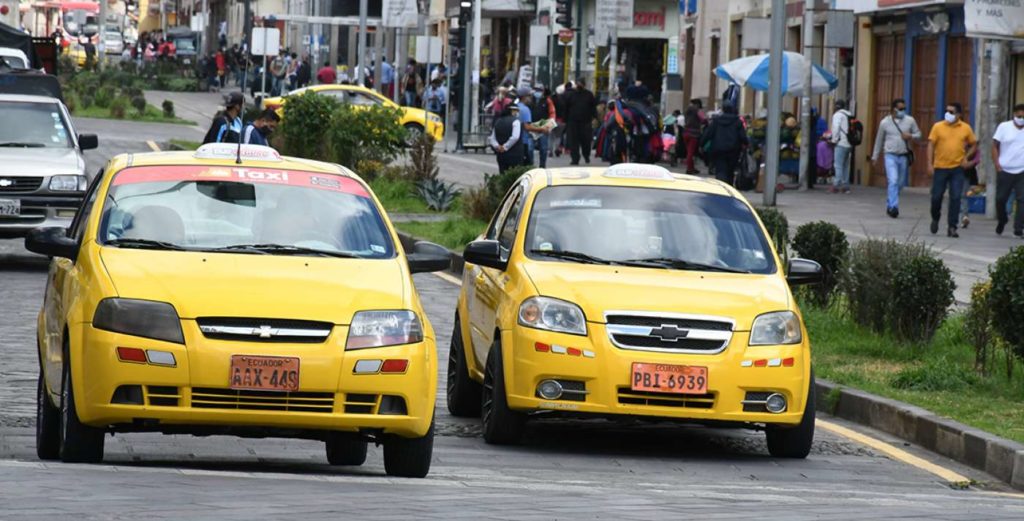 Cuenca’s other preferred means of public transportation is its vast fleet of yellow taxis, that prior to the health emergency used to be available at a moment’s notice at any street corner in the city—or, in the middle of the road for that matter!
Cuenca’s other preferred means of public transportation is its vast fleet of yellow taxis, that prior to the health emergency used to be available at a moment’s notice at any street corner in the city—or, in the middle of the road for that matter!
Well, the good news is that the taxis are operating 7 days a week again. That’s after the Taxi Guild made a request to the National COE to allow taxis to operate on Sundays, regardless of their license plate number.
Now, there are about 3,600 units authorized to operate in the city; however only 50% of those units are currently operating. Each taxi can operate three days a week, based on the last number of its license plate, and on Sundays.
Nonetheless, Azutaxi, the popular taxi application, is now receiving between 4,000 and 6,000 requests for service daily.
In addition to less taxis on the streets, one of the changes that passengers will now have to get used to are the partitions between the front and back seats that are being seen in many of the taxis in the city.
Taxi owners have begun installing the partitions as a precautionary measure to prevent the transmission of the coronavirus. The partitions themselves are made of plastic and acrylic.
However, the use of these partitions is currently not allowed under the rules of the Vehicle Technical Review (VTR). One of the taxi unions has already requested a change in the review requirements with the Mobility, Transit and Transport Commission of the Cantonal Council of Cuenca.
PLANES
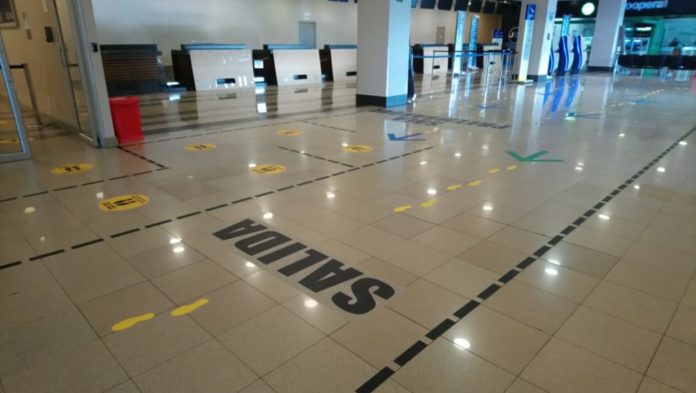 With the exception of repatriation and humanitarian flights, airline travel has been almost completely suspended throughout the country since the announcement of the health emergency on March 16, 2020.
With the exception of repatriation and humanitarian flights, airline travel has been almost completely suspended throughout the country since the announcement of the health emergency on March 16, 2020.
We say, “almost completely,” as there have been some international flights operating since June 1, 2020, as well as other flights out of Quito’s Mariscal Sucre airport.
Mariscal Sucre and Guayaquil’s Jose Joaquin de Olmedo airport are now operating commercial international flights.
Travel to and from Cuenca’s Mariscal La Mar has been restricted since the health emergency began. It did operate 50 logistical, medical, military, police and humanitarian flights during the quarantine period.However, commercial service to and from Cuenca was reactivated on June 15, 2020.
Last Friday, June 12, 2020, Cuenca’s Mayor Pedro Palacios toured the airport with representatives from the Airport Corporation, who were in charge of establishing the biosafety protocol for the reopening of the airport.
Airport Corporation’s, Juan Pablo Vega,explained how the protocol will be followed by passengers from the moment they enter the terminal until they board their plane. Airlines will coordinate with the airport to ensure that biosafety measures are continuous once the passenger enters the aircraft.
In the boarding areas of the airport, there is now signage on each seat indicating the spaces that passengers can occupy, to respect the recommended 2-meter social distance. On the floor there are also “circles of life,” so that people know where to walk and how much space to leave between the passengers in front of, and behind them.
As of June 15, 2020, there are now 6 flightsweekly in and out of the airport. On Monday and Wednesday, there are morning flights arriving from Quito (8:05 a.m.) and returning to Quito (9:04 a.m.). On Fridays, one afternoon flight arrives from Quito (4:31 p.m.) and one returns to Quito (5:30 p.m.).
More flights are expected to be added as demand warrants. However, as this time the only airline servicing Cuenca is LATAM. The entire LATAM fleet has an air recirculation system that renews it every three minutes through High Efficiency Particulate Air (HEPA) filters, removing 99.97 percent of airborne particles. LATAM expects to go from five, to nine percent of its total pre-pandemic capacity immediately, and to 18% percent in July.
The public airline TAME EP has closed operations and Aeroregional, another airline that serviced Cuenca prior to the health emergency, has not yet confirmed its return to Cuenca.
For the immediate future only ticket passengers and companions for passengers with disabilities and children, will be allowed access to the airport lounges and hallways.
IMPORTANT BEFORE YOU FLY: Under “Protocol for Entering the Country, Permanence and Exit of Mandatory Preventive Isolation During the Validity of the State of Exception,” issued on May 12, 2020, there is a mandatory requirement for every person entering Ecuador, as of June 1, 2020, to present upon arrival to the health and immigration authorities, the “negative” result of the COVID-19 PCR test, which determines that the traveler is free of the disease.
The collection of the sample for the PCR test must have been obtained in a health center or laboratory authorized by the country of origin of the trip, within a maximum of 72 hours before the date of entry into Ecuador.
The traveler must report that they have the negative proof to the airline at the time of boarding, exhibiting the certification of the laboratory, which they must also present to the Ecuadorian authorities at the point of immigration entry. No airline will allow the boarding of a passenger who does not have a PCR test.
BICYCLES
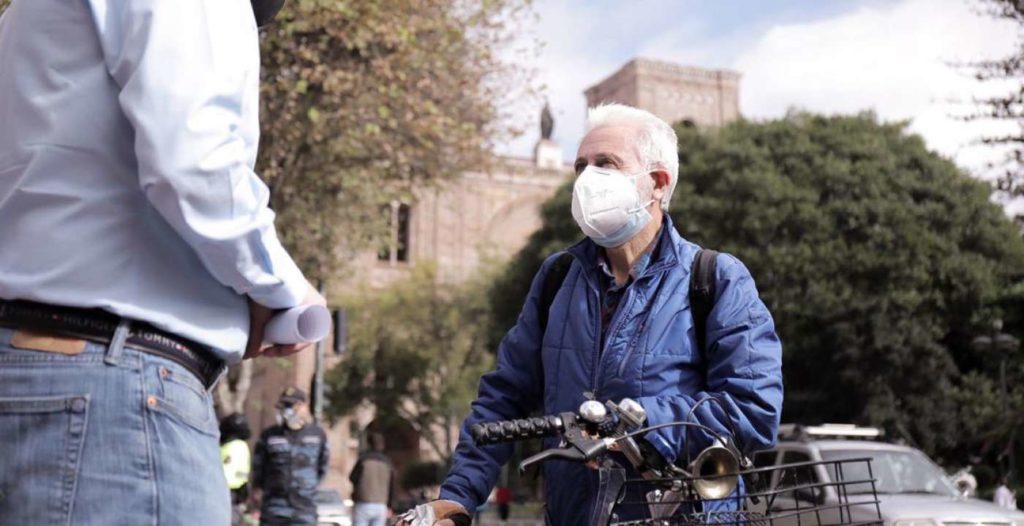 Bicycles have long been a part of Cuenca’s culture. It’s not uncommon to see someone riding down the rode on a bicycle carrying a weed whacker and maybe even a machete. It’s all a matter of balance, right?
Bicycles have long been a part of Cuenca’s culture. It’s not uncommon to see someone riding down the rode on a bicycle carrying a weed whacker and maybe even a machete. It’s all a matter of balance, right?
Well, one thing is for certain, the pandemic has increased the use of bicycles throughout the city. Buses stopped, taxis were nowhere to be found and walking was not going to get you somewhere quickly.
Add to that the health benefits and the fact that the city was actually pushing the idea of bicycling, and Cuenca was bound to see an increase in this form of mobility.
Biking gets a big push in Cuenca
Due to the health emergency generated by COVID-19, on May 30, 2020, the Municipality of Cuenca’s Mobility Directorate actually implemented a bicycle path emergency plan for the city.
The Cantonal Council of Cuenca approved the Ordinance for the promotion and strengthening of “active mobility.” With this new ordinance, the city will allocate specific funds for the planning, implementation and maintenance of bike lanes, as well as for the execution of strengthening and education programs for active mobility. Cuenca currently has 17 kilometers of bicycle lanes, six of bicycle sidewalks and 23 of shared paths.
The municipality has committed 50% of the taxes it collects from vehicle registrations and transfers to promote the use of bicycles in the city. This amounts to about $1.5 million annually.
Before the coronavirus health emergency, only 2% of the population actively used bicycles as a means of transportation, prioritizing private vehicles more than walking or public transportation. But in recent months, bicycle use has increased by between 8% and 10%, as it is one of the safest means of social distancing.
The city has now created a Mobility Committee in which citizen groups, academia, citizen representatives, Mobility Management Directorate and the Public Company of Mobility, Transit and Transport (EMOV) of Cuenca will participate to look for solutions that improve mobility within the Cuenca canton.
The ordinance also establishes that public and private entities must have parking areas for bicycles. Likewise, buildings that have inside parking spaces will have to adapt an area that will be suitable and safe structures for bicycle storage.
Public bike
There are approximately 14,700 bicycle users in the city, according to Public Company of Mobility, Transit and Transport (EMOV) of Cuenca, which did a study on the issue 2018.
As part of the city’s response to the health emergency, EMOV reactivated its Public Bike system as a favorable means of transportation for the social distancing process.
The current number of trips for Public Bike has been increasing by 120 per day. There are now more than 200,000 being trips being taken per month and there are now plans for additional bike routes in El Ejido, Totoracocha and the Historic Center, which are the sectors with the greatest numbers of trips and users.
EMOV has developed a protocol for the proper use of the system Public Bike during the health emergency.
The safety protocol for users of thithes system consists of the mandatory use of a mask, gloves, and the use of anti-bacterial gel or alcohol, when starting and ending the trip. It is recommended that the user access the system through the application from their cell phone, in order to reduce contact with the station’s touch panel.
Bici Cuenca and EMOV personnel are in charge of controlling the operation of the system, using protective clothing and accessories to sanitize the stations and bicycles on a continuous basis.
Payment methods for using Public Bike
Riders who wish to acquire or renew memberships or make travel payments should sign up on www.bicicuenca.com or contact Bici Cuenca on WhatsApp 0979350835.
The system is accessed through two modes; purchase of memberships ranging from $30 plus VAT per year, or $15 plus VAT for three months, or by simply doing“payment per trip” through recharges, which cost $0.25 for each trip.
TRAMVIA
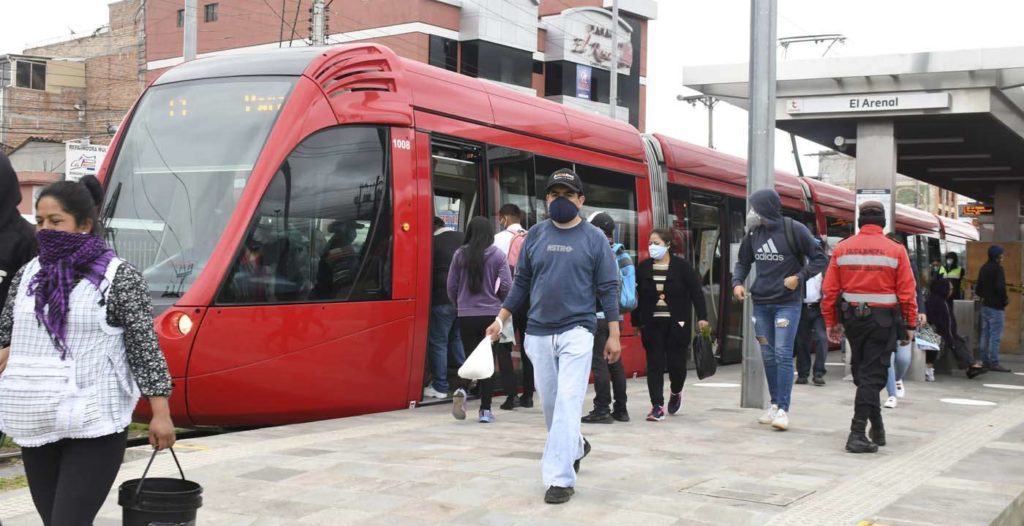 Can we say it? The Tramvia is finally operational!
Can we say it? The Tramvia is finally operational!
The pandemic has turned life upside down and changed expectations for how things are done now, and how they will be in the future. But one of the things that no one expected was for the Tramvia to actually be completed during the quarantine, and for it to begin its socialization phase (for the second time) while Cuenca is still under YELLOW epidemiologic restrictions.
But on the morning of May 25, 20202, the Cuenca Tramvia left the workshop yard, decked inside with yellow hazard tapes indicating the spaces that riders couldn’t occupy. This is one of the biosafety measures that was implemented for the citizen training phase—the second time that the Tram entered this phase (the first was during the early months of 2019, under the previous city administration).
This phase will last for 60 days under strict compliance with the biosecurity protocols established for this purpose and validated by the Cantonal COE. The Tram will run from 6:00 a.m. to 8:00p.m. and cars will pass about every 10 minutes.At the end of each route, Tramvia staff clean and disinfect all of the cars to prevent the spread of the coronavirus.
Each Tram has a capacity to carry about 300 passengers, but due to safety regulations to prevent the spread of the coronavirus, this phase is beginning with 30% occupancy.
As part of the biosafety protocols, the use of a mask or face protection is required both in the stations and inside the units. Tram users must also comply with the social distancing regulations posted in each car.

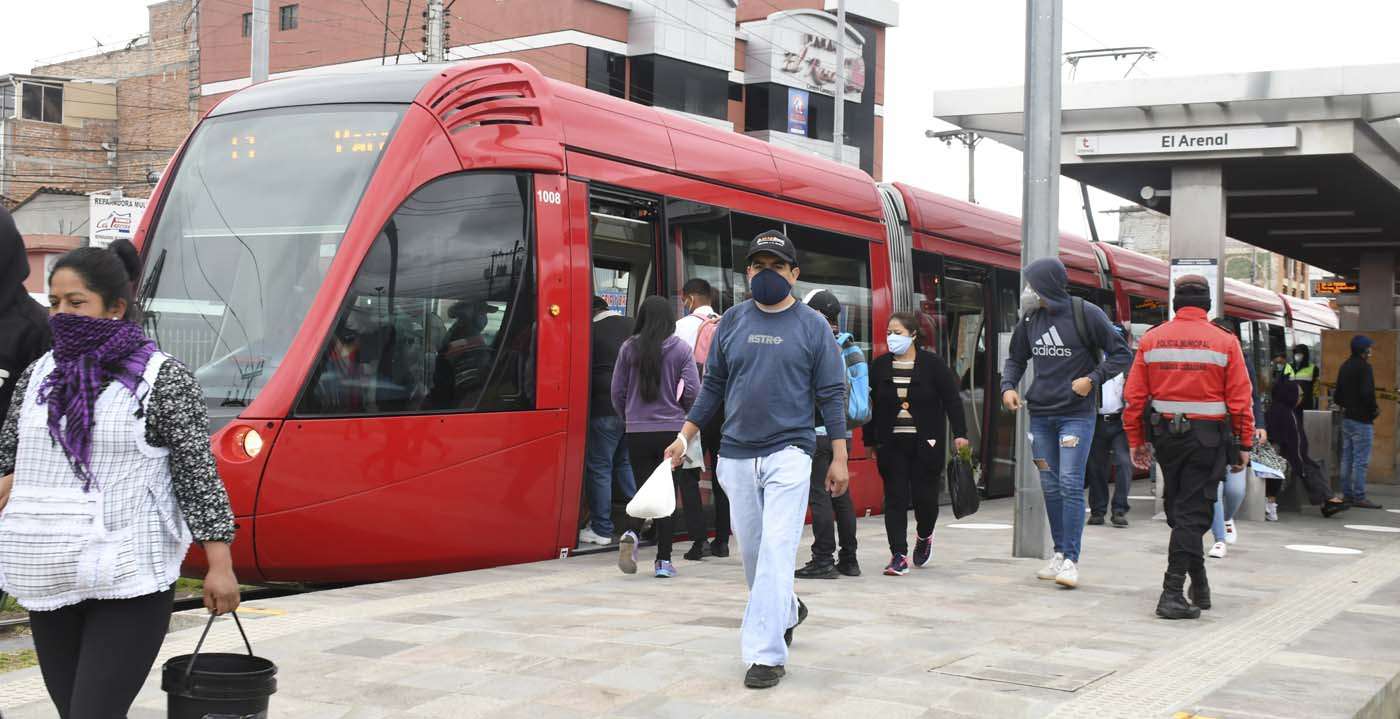
0 Comments